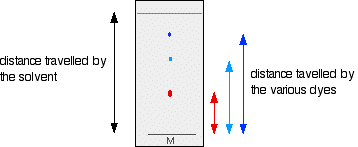- The Nucleotides Join Together between the Phosphate group of one nucleotide, and between a Sugar of another. This forms a Phosphodiester Bond (made up of the phosphate group and two ester bonds - Phospho-Di-Ester)
- The chain of Sugars and Phosphates is known as the Sugar-Phosphate Backbone
- Polynucleotides can be Broken Down into Nucleotides again by Breaking the Phosphodiester Bonds.
Double Helix
- Two Polynucleotides join together by Hydrogen Bonding Between the Bases.
- Each base can only bond with a particular partner: this is called Complimentary Base Pairing.
- Adenine (A) always pairs with Thymine (T) and Cytosine (C) always pairs with Guanine (G) (I remember it as the straight letters go together, and the curly letters go together)
- A Pyrimidine always pairs with a Purine.
- 2 Hydrogen bonds form between A-T and 3 Hydrogen Bonds form between G-C
- Two Antiparallel (going in opposite directions) polynucleotide Strands Twist to form the DNA Double Helix
Purifying DNA - Precipitation Reaction
- Break Up Cells using a blender
- Make a mixture of washing up liquid, salt, and distilled water, this mixture is called the Detergent
- Add broken cells to a beaker containing the detergent
- Put the beaker in a Water Bath (60°C) for 15 Minutes.
- Now, put the beaker in an Ice Bath, then Filter the mixture.
- Transfer a small amount of the filtered mixture to a clean boiling tube.
- Add Protease Enzymes
- Slowly Dribble some cold ethanol down the side of the boiling tube so it forms a Layer on top of the mixture.
- Leave it for a few minutes and a White Precipitate should form, which can be removed with a Glass Rod.
Self-Replication
DNA can Copy Itself before cell division
- DNA Helicase (Enzyme) Breaks the Hydrogen Bonds Between Two polynucleotide DNA Strands - The helix Unzips.
- Each Original Strand becomes a Template for a new strand. Free-Floating DNA Nucleotides Join to the exposed bases of each original strand by Complementary Base Pairing.
- The Nucleotides of the New Strand are joined together by DNA Polymerase (Another Enzyme). This forms the Sugar-Phosphate Backbone. Hydrogen Bonds Form between the bases on the Original and New Strand. It then Twists to form a Double Helix.
- Each new DNA molecule contains One strand from the Original DNA Molecule and One New Strand





